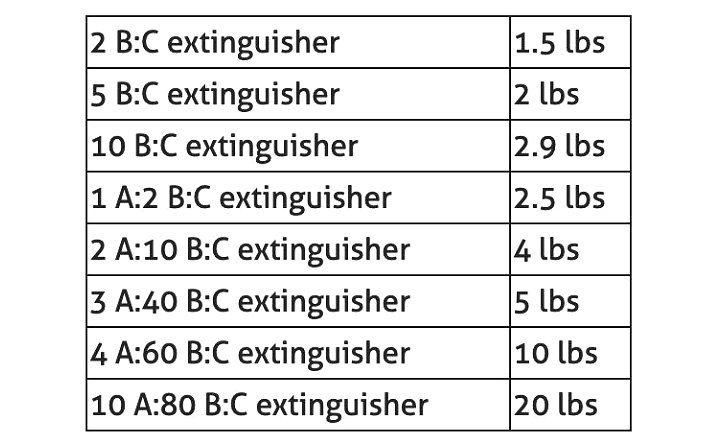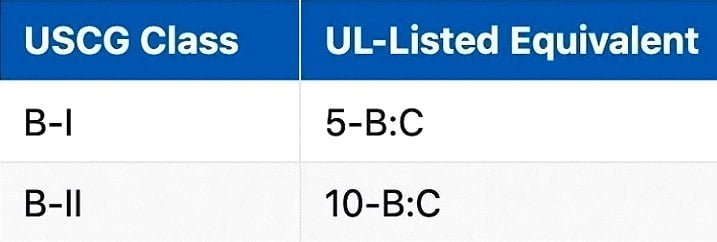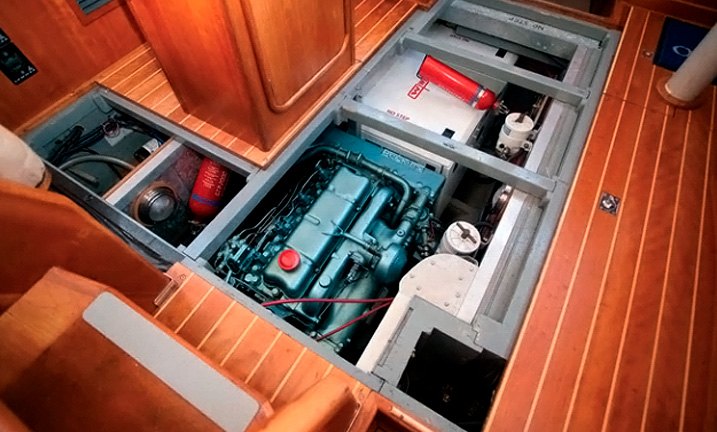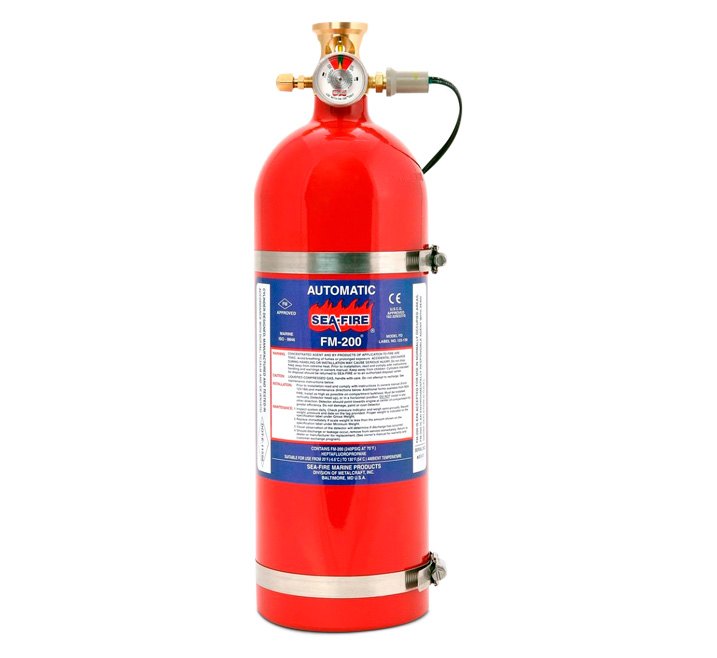On a boat, a fire extinguisher is a valuable thing to have, because it only takes minutes for an onboard fire to engulf an entire craft. There's no time to call others or radio for help and, like it or not, the only person you can rely on for immediate action is yourself. Plain and simple, you're not prepared to go on the water unless you've got fire extinguishers on board.

Fire extinguishers are essentially large pressurized aerosol cans containing solid, liquid, or gas extinguishing agents specifically formulated to put out a fire by neutralizing any of the three necessary elements for combustion: oxygen, heat, and fuel. Compressed propellants inside the canister do the work of pushing extinguishing agents out with force when the trigger handle is squeezed.

In this article, we break down how fire extinguishers are classified based on types of fires they're formulated to fight, and we cover the extinguishing agents contained within. We'll also guide you through applicable products available on our website, where you'll find fire extinguishers for all needs. There, you'll find extinguishers designed to activate automatically when no one's around, and you'll even find "clean" extinguishers which are safe for electronics because no foam or residue is left behind.
Fire Extinguisher Classes & What They Mean
OSHA regulations require all portable fire extinguishers sold in the United States to be tested and certified with 1 of 5 classification ratings signifying the type(s) of fires they are formulated to extinguish. You'll see classification approval certifications by the "UL" (Underwriters Laboratories, Inc) and/or "NFPA 10" (National Fire Protection Association).

Class A

Class A extinguishers are formulated to smother out basic fires involving solid materials such as fabrics, wood, paper, rubber, and many plastics found on boats - including fiberglass-reinforced hulls and decks.
Class B

Class B extinguishers are formulated to work most effectively on fires involving flammable fuel type liquids such as gasoline, oil, propane, kerosene, alcohols, and more. By inhibiting the release of combustible vapors that keep these flames fed, the fire is smothered out.
Class C

Class C extinguishers are intended only for fires where live electrical current is, or could potentially be, involved thanks to propellants that do not conduct electricity. Once any electrical equipment is unplugged or de-energized, a Class A or B extinguisher can safely be used.
Class D

Class D extinguishers are uniquely designed for fires involving flammable metals such as magnesium, titanium, sodium, etc used in commercial manufacturing processes. Propellants are formulated to ensure they don't chemically react with burning metals. Because Class Ds are expensive and unnecessary on boats, we don't offer them on our site.
Class K

Class K extinguishers are designed for fires based on animal/vegetable oils, cooking fats, and greases that typically originate in commercial kitchens. These use a mix of alkaline propellants designed to create a soapy foam on contact with fatty acids which extinguishes the flames.
Fire Extinguisher Ratings
A-B-C Ratings Used In "UL" & "NFPA 10" Certifications
For the purposes of this article, we'll focus on A, B, and C ratings that are applicable to the types of extinguishers designed for boats.

Most fire extinguishers are designed to be used on multiple types of fires and will be labeled A, A-B, B-C, or A-B-C accordingly. More specifically, extinguishers are assigned one or a series of letter ratings to define which classes of fires they're intended for - along with numbers in front of each letter to show the size of the fire it can handle. For example, an extinguisher that's rated 4-A, 60-B:C signifies:
"4-A" - This extinguisher is rated for Class A fires, and is given a water equivalency number in front of the A where 1 equals the effectiveness of 1.25 gallons of water. Therefore, a "4-A" number multiplied by 1.25 equals 5 gallons of water equivalency contained within that extinguisher.
"60-B:C" - Any "B" or "B:C" designation uses a number in front of the B to show the square footage of fire it can handle. Thus, "60:B" (class B fire only) or "60-B:C" (class B and C fires) designations signify 60 square feet of coverage.
No specific numeric rating exists for Class C because such fires are basically Class A or B ones where live electrical equipment is involved. To earn a "C" designation, the contents in the extinguisher must be non-conductive.

U.S. Coast Guard Rating Designations

The United States Coast Guard classifies fire extinguishers by the weight of the substrates inside, not by the type and size of fire they are designed for. For reference, a B-I class extinguisher is roughly equivalent to a 5-B:C UL-rated one, and a B-II class extinguisher is equivalent to a 10-B:C rated one. Below, we discuss how Coast Guard fire extinguisher ratings apply to regulations governing all boats in United States waters.
Are Fire Extinguishers Required By Law On Boats?
Coast Guard regulations do not require fire extinguishers on boats less than 26 feet in length equipped with outboard motors and no enclosed compartments for engines or permanently-installed fuel tanks where flammable vapors can build up. Additionally, these smaller boats must be used for personal pleasure and cannot be used for carrying paid passengers.

Otherwise, extinguishers must be on board. For boats up to 26 feet, one "B-I" size extinguisher would be required. Boats measuring between 26 - 40 feet long must carry two B-I size extinguishers or one B-II extinguisher, and boats between 40 - 65 feet must carry three B-I or two B-II extinguishers.
Types Of Extinguishing Agents
Below are common fire extinguisher agents used in products we offer.
Dry Chemical - Offers best-value pricing along with relatively low toxicity. Effective on Class B and Class C fires, but not effective on Class A fires. Leaves residue that is difficult to clean.
Carbon Dioxide (CO2) - Effective for Class B and Class C fires, and is recommended for use only in confined interior spaces. Extinguishes fire by removing oxygen rather than by cooling. Leaves no residue and does not require expensive clean-up.
FM-200 - A synthetic suppression gas that extinguishes a fire by removing heat from the oxygen-fuel-heat reaction. Leaves no residue and does not require expensive clean-up.
Halotron 1 - This is EPA-approved for low toxicity. Safest to use on computers, electronics, and even clean rooms. Leaves no residue and does not require expensive clean-up.
Manual Vs. Automatic Fire Extinguishers
As their name suggests, manual fire extinguishers must be triggered by the user manually squeezing the handle. Automatic fire extinguishers, however, are designed to trigger themselves automatically when a built-in sensor detects a certain air temperature has been reached. Automatic extinguishers can also be triggered manually should the need arise.

If you've got an enclosed engine bay or engine room, an automatic fire extinguisher is a must-have item. Why? Because those are the spots where 90 percent of boat fires start, according to Coast Guard statistics. The most common causes are electrical wiring and circuitry issues, overheated engines and/or transmissions, and fuel leaks. Although trouble usually starts during or shortly after boat use, fires in a contained area aren't always noticeable immediately. And they can also start long after the boat's been docked and left unattended.

Once triggered, automatic fire extinguishers release agents that smother an enclosed fire quickly. After discharging or when monitor batteries are low, the unit will let you know with regular audible beeps. Some automatic extinguishers offer the option of a remote status display gauge which can be mounted on your dashboard - these will be displayed in the Product Options selection field.

We recommend the Sea Fire Marine Manual/Auto Non-Rechargeable Fire Extinguisher (FM200) which features heat-actuated automatic discharge, pressure display gauge, and fitted mounting bracket. In Product Options, you can select the right size for your needs ranging from 25 to 200 square feet of capacity.
Manual Fire Extinguishers We Offer
For best values, check out the Seachoice Fire Extinguisher (dry chemical, 10-B:C rated), Kidde Mariner 110 Fire Extinguisher (dry chemical, 1-A:10-B:C rated), Kidde 2.5lb FC110 Extinguisher w/Metal Valve & Plastic Strap Bracket (dry chemical) 1-A:10-B:C rated), and the Eddie Marine 1-lb Fire Extinguisher that's available in standard red or optional chrome finish (dry chemical, 2-B:C rated). For larger spaces, we've got extinguishers such as the Kidde Pro 10 MP Fire Extinguisher (dry chemical, 4-A:60-B:C rated) and Kidde Pro 20 MP Fire Extinguisher (dry chemical, 6-A:80-B:C rated).

If you prefer manual fire extinguishers that leave no foamy residue, we've got several choices. The Kidde CO2 Fire Extinguisher uses carbon dioxide and is available in sizes up to 10-B:C. The Kidde Halotron Fire Extinguisher w/Wall Hook (choose sizes up to 2-A:10-B:C rating) features halotron substrate which is safest to use on sophisticated electronics such as computers, electronics, and even clean rooms.

In conclusion, we'll note that in addition to fire extinguishers, we also carry a variety of brackets and other related accessories as well as other safety items such as first aid kits, life vests, life rafts & survival gear, survival electronics, signaling devices & safety lights, and more.
We also encourage you to browse through other sections of BOATiD where you'll find some great marine electronics for navigation, cartography and communication, replacement parts for engine & assorted trim items, anchors and docking-related components, plumbing & sanitation products, lighting needs, maintenance & winterization, sailing-related parts & components, and much more. Should you have questions about anything on our website, we'll be happy to help seven days a week!
